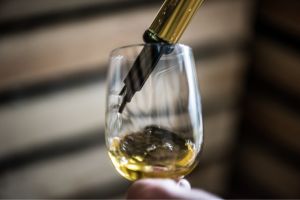386: Managing Cider's Secondary Fermentation - DIY Tips - a podcast by Ria Windcaller: Award winning Cidermaker | Craft Libations Columnist | Podc
from 2023-11-08T08:00
::
::
The Purpose of Secondary Fermentation when Making Cider
Improve the overall quality and characteristics of the final product during secondary fermentation by;
- Clarification: During primary fermentation, yeast converts sugars into alcohol, creating a cloudy mixture with suspended yeast and particulate matter. Secondary fermentation allows these particles to settle over time, resulting in clearer cider.
- Stabilization: Secondary fermentation helps to stabilize the cider by allowing it to age in a less active state. This aging process can reduce the risk of off-flavors and other fermentation by-products that can negatively impact the cider.
- Reduction of Sediment in Bottles: By allowing most of the sediment to settle out in the fermentation vessel rather than in the final packaging, secondary fermentation ensures a cleaner, more professional-looking bottled cider.
- Risk Reduction: Transferring cider to a new vessel after primary fermentation reduces the risk of contamination from dead yeast cells that can autolyze (break down) and potentially create off-flavors.
Secondary fermentation is a crucial step for refining cider, enhancing its clarity, taste, and stability before it is consumed or sold.

Past Cider Making Episodes
- 381 DIY Cider Making for Beginners
- 382 Beginner Tips for Squeaky Clean Cider Equipment
- 384 Beginner Cider Making Tips forPrimary Fermentation
Equipment needed for Cider’s Secondary Ferment
Find a complete list with links to purchase at the Cider Making Equipment page at ciderchat.com
- Extra Apple Juice to for topping off
- Secondary Fermenter – glass carboy of equal size
- Airlock and Bung
- Racking Cane or Auto-Siphon
- Sanitizer
- Hydrometer or Refractometer
- Tubing & a clothes pin ( a Ria tip to have on hand for clamping tubing as you go so it can be managed to insure that the tube doesn’t slip down into the lees and stir them up)
- Bottle Brush and Cleaning Equipment
Determining when Secondary Fermentation Begins
- Completion of Active Primary Fermentation: Watch and notice when the vigorous phase of primary fermentation is complete, which is typically indicated by a significant decrease in airlock activity or specific gravity readings that are close to the target final gravity.
- Gravity Readings: Use a hydrometer or refractometer to take consecutive gravity readings over a few days. When readings are consistent, it suggests that fermentation has slowed down enough for secondary transfer.
- Visual Clues: Look for a drop in the level of visible activity, such as the reduction of bubbles and the beginning of sediment formation at the bottom of the primary fermenter.
- Taste Test: Conduct a taste test for residual sweetness. If the cider is too sweet, it may need more time in primary fermentation unless the desired style of cider is sweet rather than dry.
- Timeframe Guidance: Generally, primary fermentation can take anywhere from a few days to two weeks, depending on factors like temperature, yeast strain, and original sugar content.
- Avoiding Off-Flavors: Transfer before the cider has sat too long on the lees at the bottom of the carboy to prevent off-flavors that can result from yeast autolysis.
- Specific Style Goals: Factor in the specific goals for the cider’s style, as some styles may benefit from a longer or shorter primary fermentation before secondary.
- Equipment Availability: Ensure that the secondary fermentation vessel is prepared and sanitized before deciding on the transfer to avoid any delays once the cider is ready.
Common Problems during Secondary Ferment
- Stalled Fermentation – Adjust fermentation temperature to optimal range.
- Excessive Oxidation – Minimize headspace and avoid splashing when transferring.
- Contamination – Practice stringent sanitation and possibly discard contaminated batch.
- Sulfite Burn – Allow time for dissipation or use activated carbon treatment.
- Insufficient Carbonation – Verify yeast viability and sugar availability; maintain proper bottle conditioning temperature.
- Sediment in Bottles – Allow full clearing in secondary, use fining agents, and bottle carefully.
- Unexpected Flavor Changes – Allow time for maturation or blend with another batch.
- Pressure Build-up in Containers – Use an airlock or periodically vent the container.
- Cider Becomes Too Dry – Monitor gravity to stop fermentation at desired sweetness or back-sweeten with non-fermentable sweeteners.
Mentions in this Cider Chat
- Past Cider Making Episodes:
- CiderCon 2024 January 16th-19th, 2024 Portland, Oregon
- Ross Cider and Perry Company
- ciderGoingUp Campaign page
Further episodes of Cider Chat
Further podcasts by Ria Windcaller: Award winning Cidermaker | Craft Libations Columnist | Podc
Website of Ria Windcaller: Award winning Cidermaker | Craft Libations Columnist | Podc